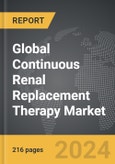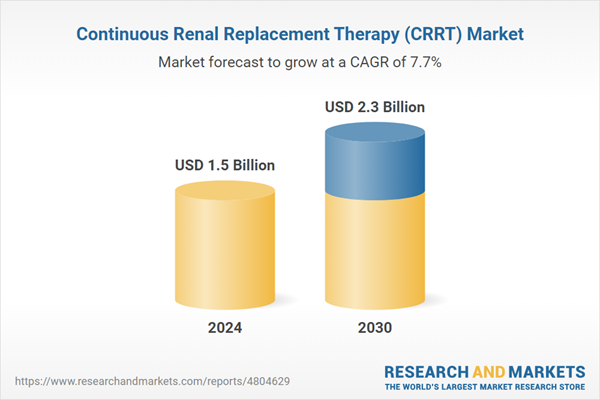Global Continuous Renal Replacement Therapy (CRRT) Market - Key Trends & Drivers Summarized
What Is Fueling Innovation in CRRT Systems and Consumables Across ICU Settings?
Continuous Renal Replacement Therapy (CRRT) has become an indispensable component of critical care nephrology, especially in managing acute kidney injury (AKI) among hemodynamically unstable patients. At the heart of this treatment ecosystem lie two pivotal product segments-CRRT systems and CRRT consumables. CRRT systems encompass advanced machines engineered for 24-hour extracorporeal blood purification, often equipped with volumetric balancing, fluid removal precision, and automated safety features. These systems are evolving rapidly through digital integration, sensor-driven flow management, and touchscreen operability, aimed at reducing manual intervention in intensive care units. Market leaders are now developing compact, software-optimized machines with closed-loop monitoring capabilities, enabling real-time adjustments in therapy delivery.Simultaneously, CRRT consumables-including hemofilters, dialyzers, blood tubing sets, and replacement fluids-are witnessing increased innovation in material sciences and biocompatibility. The rising prevalence of septic shock and multi-organ failure is boosting the demand for high-performance membranes capable of enhanced cytokine clearance. Manufacturers are investing in anti-coagulant-coated hemofilters and sterile pre-connected bloodline kits that reduce infection risk and minimize treatment downtime. Moreover, the surge in demand for disposable and pre-assembled consumables has intensified with growing awareness of hospital-acquired infections, prompting a shift toward single-use products. Supply chain developments are also shaping regional dynamics, as the localization of consumable production becomes a strategic priority in light of tariff complexities and cross-border regulatory friction.
How Are CRRT Modalities Diversifying to Meet Clinical and Operational Needs?
The CRRT modality landscape is stratified into four distinct types-Continuous Venovenous Hemofiltration (CVVH), Continuous Venovenous Hemodiafiltration (CVVHDF), Continuous Venovenous Hemodialysis (CVVHD), and Slow Continuous Ultrafiltration (SCUF). Each is tailored to specific fluid management, solute clearance, and hemodynamic conditions. CVVH continues to gain traction for its superior convective clearance of medium to large molecules, making it suitable for hypercatabolic patients. It is often deployed in post-surgical and trauma cases where rapid removal of inflammatory mediators is crucial. The growing reliance on cytokine modulation therapies is reinforcing CVVH's role, particularly in cases of septic AKI.CVVHDF, which combines both diffusive and convective modalities, is emerging as the modality of choice in tertiary care centers due to its comprehensive solute clearance profile and balanced fluid management. It is particularly suited for patients with complex acid-base and electrolyte disturbances, making it popular in high-acuity ICUs. CVVHD, though primarily diffusion-based, remains relevant in situations requiring gentler clearance, such as in pediatric or elderly patients with borderline perfusion. SCUF, on the other hand, is utilized for pure ultrafiltration needs in volume-overloaded patients with relatively stable solute levels. Its simplicity and lower resource requirement make it an attractive choice in resource-constrained environments or step-down units. With increasing algorithm-driven personalization of CRRT prescriptions, hybrid modes and tailored treatment durations are becoming mainstream. This diversification is not only improving patient outcomes but also allowing clinicians to optimize ICU resource utilization.
Which Care Settings Are Creating New Demand Frontiers for CRRT Technologies?
Historically dominated by hospital ICUs, the CRRT market is undergoing a structural shift in terms of end-use environments. Hospitals continue to dominate overall demand, particularly tertiary and quaternary centers equipped with nephrology and critical care specialties. These institutions are the primary adopters of fully automated CRRT systems and high-precision fluid delivery platforms. However, a new wave of demand is emanating from ambulatory care units and regional specialty clinics that are increasingly handling post-acute care of AKI and critically ill patients who no longer require ventilation but still need renal support. This trend is further enabled by miniaturized CRRT platforms that can be deployed in semi-ICU settings with lower nurse-to-patient ratios.In parallel, the concept of delivering CRRT in homecare or extended-care facilities is gaining slow but noteworthy traction. While full-scale CRRT at home is not yet a norm due to clinical risk and infrastructure constraints, ongoing trials and pilot projects in chronic renal recovery scenarios are exploring safe outpatient models for low-flow filtration and fluid removal. These solutions are targeted at patients transitioning from ICU to rehabilitation settings. Technological advances like battery-powered modules, remote monitoring through IoT-enabled dashboards, and simplified user interfaces are paving the way for decentralized renal support. Furthermore, government-funded initiatives and insurance coverage reforms in regions like North America and Japan are incentivizing non-hospital-based critical care infrastructure. This is encouraging CRRT providers to offer portable and scalable solutions, enabling modular expansion of renal support programs beyond traditional ICU boundaries.
What Is Driving the Accelerated Growth of the Global CRRT Market?
The growth in the global Continuous Renal Replacement Therapy market is driven by several factors rooted in clinical demand patterns, technological evolution, and systemic healthcare transformation. At the core lies the rising prevalence of acute kidney injury, particularly among the aging population and critical care patients suffering from sepsis, cardiac complications, or multi-organ dysfunction. These clinical conditions often require continuous extracorporeal therapy for effective fluid and solute management, reinforcing sustained demand for both CRRT systems and consumables. Additionally, the growing burden of non-communicable diseases, including diabetes and hypertension, is increasing the susceptibility to renal failure during ICU admissions, expanding the target pool for CRRT adoption.On the technological front, the market is being propelled by the development of intelligent CRRT platforms that integrate advanced flow control algorithms, pressure sensors, and digital feedback loops. These features not only enhance patient safety but also improve efficiency in dosing, fluid balancing, and anticoagulation management. Furthermore, interoperability with hospital EMRs and ICU command centers is enabling seamless data exchange and enhancing clinical decision-making. Meanwhile, consumer behavior is shifting toward early intervention and proactive monitoring, driving higher adoption of high-dependency care models equipped with advanced renal support.
Policy changes and hospital reimbursement frameworks are also shaping demand. In developed markets, bundled payment reforms and diagnosis-related group (DRG) adjustments are encouraging cost-effective ICU therapies that reduce hospitalization length-an area where CRRT demonstrates tangible impact. Moreover, in emerging economies, international donor programs and public-private partnerships are supporting CRRT infrastructure development in tertiary hospitals. These multifaceted drivers-ranging from demographic pressures and evolving ICU protocols to digitization, miniaturization, and payer incentives-are collectively accelerating the global momentum of the CRRT market across care settings and technology tiers.
Report Scope
The report analyzes the Continuous Renal Replacement Therapy (CRRT) market, presented in terms of market value (USD). The analysis covers the key segments and geographic regions outlined below.- Segments: Product Type (CRRT Consumables, CRRT Systems); Modality (Continuous Venovenous Hemofiltration (CVVH), Continuous Venovenous Hemodiafiltration (CVVHDF), Continuous Venovenous Hemodialysis (CVVHD), Slow Continuous Ultra-Filtration (SCUF)); End-Use (Hospitals End-Use, Ambulatory Care End-Use, Other End-Uses).
- Geographic Regions/Countries: World; United States; Canada; Japan; China; Europe (France; Germany; Italy; United Kingdom; and Rest of Europe); Asia-Pacific; Rest of World.
Key Insights:
- Market Growth: Understand the significant growth trajectory of the CRRT Consumables segment, which is expected to reach US$1.5 Billion by 2030 with a CAGR of 8.6%. The CRRT Systems segment is also set to grow at 6.1% CAGR over the analysis period.
- Regional Analysis: Gain insights into the U.S. market, valued at $518.7 Million in 2024, and China, forecasted to grow at an impressive 9.1% CAGR to reach $309 Million by 2030. Discover growth trends in other key regions, including Japan, Canada, Germany, and the Asia-Pacific.
Why You Should Buy This Report:
- Detailed Market Analysis: Access a thorough analysis of the Global Continuous Renal Replacement Therapy (CRRT) Market, covering all major geographic regions and market segments.
- Competitive Insights: Get an overview of the competitive landscape, including the market presence of major players across different geographies.
- Future Trends and Drivers: Understand the key trends and drivers shaping the future of the Global Continuous Renal Replacement Therapy (CRRT) Market.
- Actionable Insights: Benefit from actionable insights that can help you identify new revenue opportunities and make strategic business decisions.
Key Questions Answered:
- How is the Global Continuous Renal Replacement Therapy (CRRT) Market expected to evolve by 2030?
- What are the main drivers and restraints affecting the market?
- Which market segments will grow the most over the forecast period?
- How will market shares for different regions and segments change by 2030?
- Who are the leading players in the market, and what are their prospects?
Report Features:
- Comprehensive Market Data: Independent analysis of annual sales and market forecasts in US$ Million from 2024 to 2030.
- In-Depth Regional Analysis: Detailed insights into key markets, including the U.S., China, Japan, Canada, Europe, Asia-Pacific, Latin America, Middle East, and Africa.
- Company Profiles: Coverage of players such as Toray Industries, Inc., B. Braun Melsungen AG, Medtronic PLC, Baxter International, Inc., B. Braun Medical, Inc. and more.
- Complimentary Updates: Receive free report updates for one year to keep you informed of the latest market developments.
Some of the 27 companies featured in this Continuous Renal Replacement Therapy (CRRT) market report include:
- Toray Industries, Inc.
- B. Braun Melsungen AG
- Medtronic PLC
- Baxter International, Inc.
- B. Braun Medical, Inc.
- Fresenius SE & Co. KGaA
- Nikkiso Co., Ltd.
- Fresenius Medical Care AG & Co. KgaA
- Asahi Kasei Medical Co., Ltd.
- Medica SpA
- NxStage Medical, Inc.
- Nipro India Corporation Pvt., Ltd.
- Xenios AG
- Infomed SA
This edition integrates the latest global trade and economic shifts into comprehensive market analysis. Key updates include:
- Tariff and Trade Impact: Insights into global tariff negotiations across 180+ countries, with analysis of supply chain turbulence, sourcing disruptions, and geographic realignment. Special focus on 2025 as a pivotal year for trade tensions, including updated perspectives on the Trump-era tariffs.
- Adjusted Forecasts and Analytics: Revised global and regional market forecasts through 2030, incorporating tariff effects, economic uncertainty, and structural changes in globalization. Includes historical analysis from 2015 to 2023.
- Strategic Market Dynamics: Evaluation of revised market prospects, regional outlooks, and key economic indicators such as population and urbanization trends.
- Innovation & Technology Trends: Latest developments in product and process innovation, emerging technologies, and key industry drivers shaping the competitive landscape.
- Competitive Intelligence: Updated global market share estimates for 2025, competitive positioning of major players (Strong/Active/Niche/Trivial), and refined focus on leading global brands and core players.
- Expert Insight & Commentary: Strategic analysis from economists, trade experts, and domain specialists to contextualize market shifts and identify emerging opportunities.
Table of Contents
Companies Mentioned (Partial List)
A selection of companies mentioned in this report includes, but is not limited to:
- Toray Industries, Inc.
- B. Braun Melsungen AG
- Medtronic PLC
- Baxter International, Inc.
- B. Braun Medical, Inc.
- Fresenius SE & Co. KGaA
- Nikkiso Co., Ltd.
- Fresenius Medical Care AG & Co. KgaA
- Asahi Kasei Medical Co., Ltd.
- Medica SpA
- NxStage Medical, Inc.
- Nipro India Corporation Pvt., Ltd.
- Xenios AG
- Infomed SA
Table Information
| Report Attribute | Details |
|---|---|
| No. of Pages | 363 |
| Published | October 2025 |
| Forecast Period | 2024 - 2030 |
| Estimated Market Value ( USD | $ 1.5 Billion |
| Forecasted Market Value ( USD | $ 2.3 Billion |
| Compound Annual Growth Rate | 7.7% |
| Regions Covered | Global |









